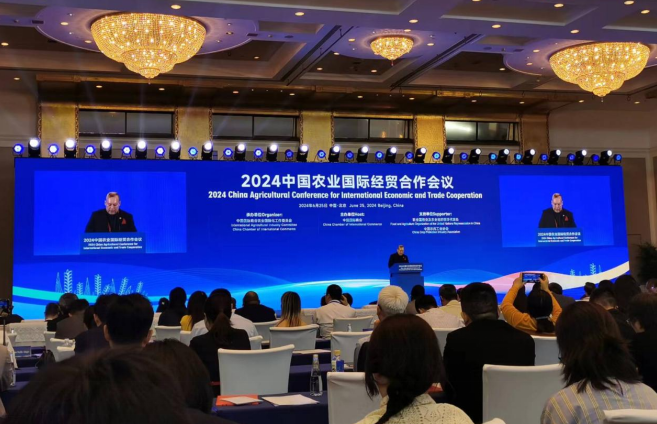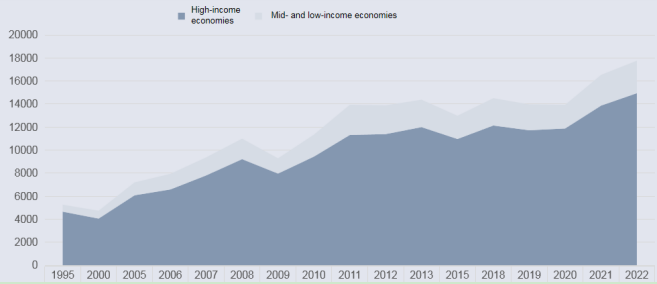Equitable agricultural trade mechanism urged to address food crisis
By Wang Kai

2024 China Agricultural Conference for International Economic and Trade Cooperation was held in Beijing on June 25[Photo/China Economic Net]
BEIJING, June 26 (China Economic Net) - "Food and climate crisis pose challenges to everyone. It requires a trade mechanism that features equity and shared responsibilities", Aldonov Frankeko Alvarez, Ambassador of El Salvador to China told China Economic Net at the 2024 China Agricultural Conference for International Economic and Trade Cooperation held in Beijing on Tuesday.
This year, global agricultural supply and trade continue to bear pressure due to a combination of factors such as sluggish global economic recovery, lingering impact of El Nino, fermenting regional conflicts, and prevalent trade protectionism.
According to the latest Global Report on Food Crises (GRFC), nearly 282 million people in 59 countries and territories experienced high levels of acute hunger in 2023, an increase of 24 million from the previous year. The Food and Agriculture Organization (FAO) of the United Nations estimated that in 2030, there will still be nearly 600 million people in the world suffering from hunger.
Non-traditional challenges striking the most vulnerable
“Unconventional factors are emerging, impacting global agricultural market”, Cheng Guoqiang, Director, National School of Food Security Strategy, Renmin University of China, shared at the conference, noting the excessive concentration of agricultural export supply as a salient problem.
Take the staple food products as an example. Five countries, i.e., Russia, Australia, the U.S., Canada, and Ukraine take up 80% of global wheat export. For maize, the top exporters account for nearly 90% of market share. Meanwhile, the imports are highly distributed among various countries. The same case happens for soybean and rice.
The Organisation for Economic Co-operation and Development (OECD) estimated the concentration is very likely to continue in the future, posing structural risks to agricultural importers, especially those lack of grain.
In addition to the dominance of a few internationals in global agricultural trade, speculation on agricultural produce, use of agricultural produce as bio-fuel, and geopolitical conflicts are complicating global food market, causing sharp fluctuations of prices, according to Cheng.
China as major growth engine for global agricultural trade
“In all crises arise opportunities. Strengthening cooperation bring us benefits”, Aldonov Frankeko Alvarez, Ambassador of El Salvador to China said to CEN, adding that negotiation for the free trade agreement between China and Salvador has been launched a month ago, which is set to open up more duty-free possibilities of agricultural trade in goods and services.
“From sugarcane to coffee and rum, our products find vast market in China. Chinese machinery has also improved our capacity of production”, he said, hailing China’s role in promoting global agricultural trade.
From 2001 to 2022, China's trade volume of agricultural products increased by 12 times, from $27.45 billion to $334.32 billion, with an average annual growth rate of 12.6 percent, higher than the 6.7 percent global average during the same period. In 2023, China's total trade in agricultural products reached $333 billion, hitting a record high despite global headwind.
In the past decade, China has signed more than 100 documents on agricultural and fishery cooperation with nearly 90 Belt and Road countries and international organizations, and trade in agricultural products has exceeded US $139.4 billion. More than 2,000 agricultural experts and technicians from China has been sent to more than 70 countries and regions, and promoting over 1,500 agricultural technologies to the rest of the world, as per Yu Jianlong, Vice Chairman of China Council for the Promotion of International Trade.
Multilateralism essential to agricultural trade equity
FAO and World Bank statistics on the distribution of income from export indicate that it is the high-income countries that are sharing the benefits of open markets and free trade in agriculture, while developing countries take a much lower proportion in the income mix.

Export income from trade (in $100 million). Statistics from World Bank, World Development Indicators, 2024
It indicates the necessity to establish an equitable governance structure of trade in agriculture, according to Cheng Guoqiang.
As a matter of fact, the overall food production globally is basically sufficient to meet people’s demands. In 2021, the world produces 776 million tons of wheat to meet 765 tons of consumption; and the production and demand for rice were 525 million tons and 523 million tons respectively.
Yet, distribution imbalance has plunged developing countries into food crisis time and again, forcing them to rely on import.
“it is partly a result of disproportionately high subsidies of the developed countries under the WTO rules. If food security continues to deteriorates, the Zero Hunger target of the United Nations Sustainable Development Goal will not be met”, Cheng warned, urging an agricultural governance system oriented towards food safety apart from trade liberalization.
(Editor: wangsu )


